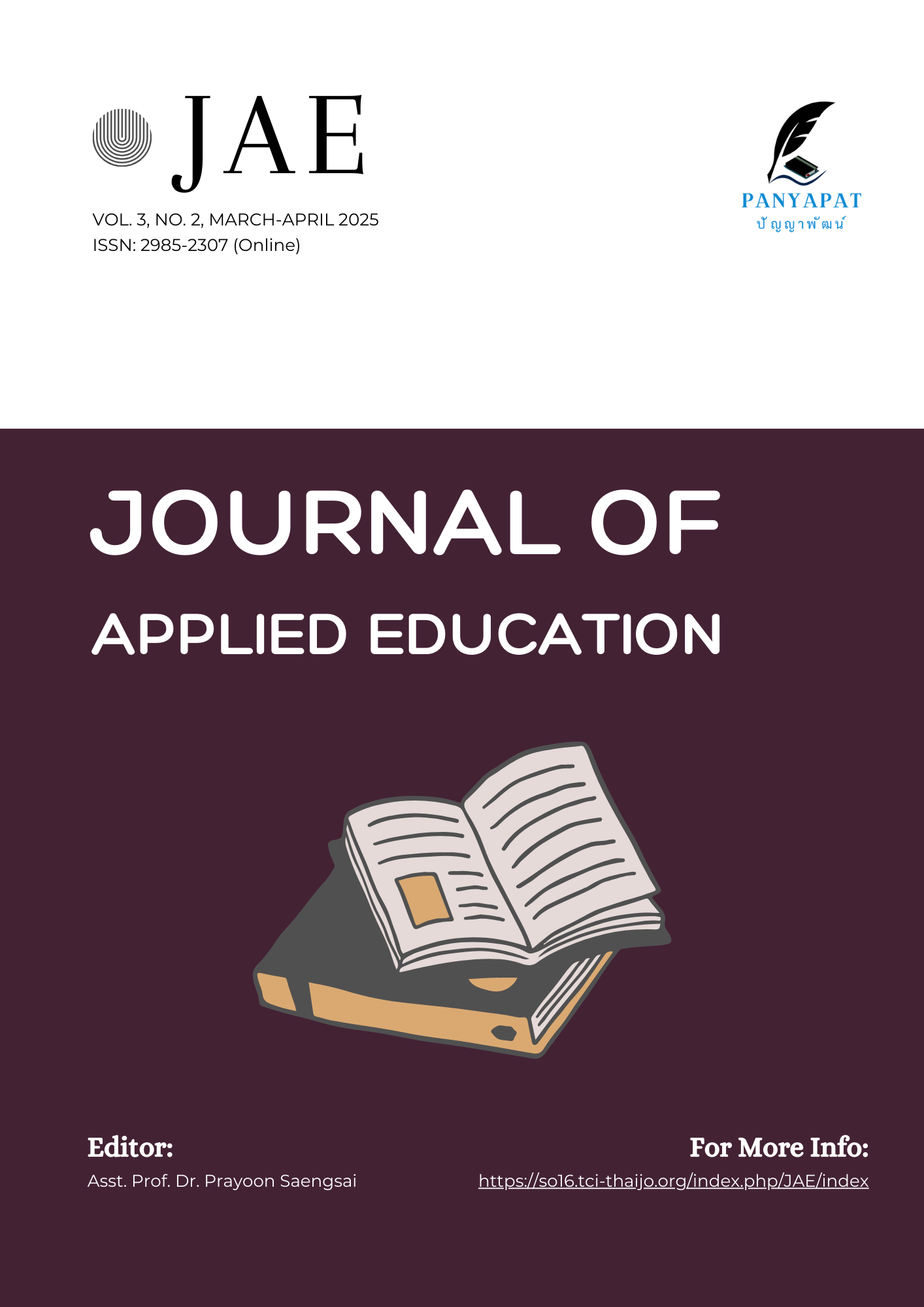Strategic Educational Management of Aekthaweewit School Toward Internationalization in the Era of Artificial Intelligence
Main Article Content
Abstract
This study aims to develop strategies for educational management at Aekthaweewit School towards Internationalization in the era of artificial intelligence. A mixed methods research design was employed, incorporating the Appreciative Inquiry Conference (AIC) process to foster participatory engagement. For the quantitative component, the sample consisted of 213 participants, comprising one school licensee, six school board members, and eighteen teachers selected through purposive sampling, along with 188 parents who were selected using simple random sampling based on Yamane’s (1973) formula. For the qualitative component, data were gathered from 27 informants, including one school administrator, one licensee, six teachers, six board members, eight parent representatives, three experts, and two research assistants, all selected through purposive sampling. Research instruments included questionnaires and data recording forms for the quantitative data, while in-depth interviews, document analysis guidelines, and participatory AIC sessions were used for qualitative data collection. Quantitative data were analyzed using descriptive statistics-mean and standard deviation—along with inferential statistics appropriate to the nature of the data. Qualitative data were analyzed through content analysis, combined with benchmarking techniques and a consensus model. The study revealed four key strategies for educational management at Aekthaweewit School towards Internationalization in the era of artificial intelligence: 1) Establishing Sustainable Educational Networks: Emphasis is placed on effective public relations and strengthening relationships with parents and the community to promote the school’s identity and image. 2) Enhancing Learning Quality to Meet International Standards: This involves the integration of digital technologies, implementation of STEAM education, and promotion of active learning approaches. 3) Improving Management Efficiency through Smart Technologies: Educational information systems (SIS) and artificial intelligence (AI) are utilized to optimize administrative processes and decision-making. 4) Empowering Personnel towards Professionalism and Sustainable Development: Focus is placed on the continuous development of teachers and staff in both instructional and managerial capacities through training programs and the application of Agile principles.
Article Details

This work is licensed under a Creative Commons Attribution-NonCommercial-NoDerivatives 4.0 International License.
References
เฉลิม จักรชุม. (2559). การพัฒนาหลักสูตรฝึกอบรมตามแนวคิดการเรียนรู้แบบผสมผสานเพื่อเสริมสร้างสมรรถนะของครูด้านการใช้เทคโนโลยีสารสนเทศและการสื่อสารในการจัดการเรียนรู้. วารสารมหาวิทยาลัยราชภัฏยะลา, 11(2), 129-143.
ประเวศ เวชชะ และ ไพโรจน์ ด้วงนคร. (2566). แนวคิด หลักการและทฤษฎีการบริหารจัดการ: การประยุกต์ใช้ในการบริหารการศึกษายุคปัญญาประดิษฐ์. เชียงราย: มหาวิทยาลัยราชภัฏเชียงราย.
ประเวศ เวชชะ. (2566). การออกแบบการวิจัย. เชียงราย: มหาวิทยาลัยราชภัฏเชียงราย.
ยงยุทธ สงพะโยม. (2565). กลยุทธ์การบริหารสถานศึกษาในยุคปกติใหม่. (ศึกษาศาสตรดุษฎีบัณฑิต, มหาวิทยาลัยศิลปากร).
ศิริวรรณ แก้วมูล และ สุรศักดิ์ สุนทร. (2566). แนวทางการประยุกต์ใช้ปัญญาประดิษฐ์ (AI) ในการจัดการศึกษา. วารสารวิจัยและพัฒนาหลักสูตร, 12(1), 1–15.
สำนักงานคณะกรรมการการศึกษาขั้นพื้นฐาน. (2568). ศธ. สยายปีกสู่เวทีโลก มุ่งเป้ายกระดับการศึกษาด้วย AI พร้อมสร้างความตระหนักรู้แก่เยาวชนในการปกป้องสิ่งแวดล้อม. สืบค้นจาก https://www.moe.go.th/ศธ-สยายปีก/.
สำนักงานคณะกรรมการส่งเสริมการศึกษาเอกชน. (2564). แผนพัฒนาการศึกษาเอกชน พ.ศ. 2560 – 2564. สืบค้นจาก https://opec.go.th/uploads/2023/plan/20230105_144543_837_3-1.pdf.
สุภาพร แซ่ลี. (2564). การพัฒนากลยุทธ์การบริหารการศึกษาผ่าน Balanced Scorecard ในโรงเรียนเอกชนกรุงเทพฯ. วารสารการบริหารการศึกษา, 28(1), 75–91.
โสภณ แย้มกลิ่น. (2567). PESTEL Analysis คืออะไร. สืบค้นจาก https://www.sophony.co/strategy/pestel-analysis-%E0%B8%84%E0%B8%B7%E0%B8%AD%E0%B8%AD%E0%B8%B0%E0%B9%84%E0%B8%A3/.
Abares, A., & Contreras, M. (2022). Adapting the Balanced Scorecard for public education systems: Lessons from Colombia. Educational Management Administration & Leadership, 50(4), 603-619.
Aguilar, F. J. (1967). Scanning the business environment. London: Macmillan.
Baker, T., & Palmer, G. (2021). Participatory planning in education: A case study of collaborative school improvement processes. Journal of Educational Administration, 59(2), 134-150.
Bangkok Bank InnoHub. (2023). การใช้ AI ในระบบการศึกษา: โอกาสและความท้าทายที่มหาวิทยาลัยกำลังเผชิญ. สืบค้นจาก https://www.bangkokbankinnohub.com/th/how-universities-respond-to-the-rise-of-ai/.
Bozkurt, A., & Sharma, R. C. (2020). Emergency remote teaching in a time of global crisis due to Corona Virus pandemic. Asian Journal of Distance Education, 15(1), 1-6.
Bryman, A. (2016). Social research methods. (5th ed.). Oxford: Oxford University Press.
Camp, R. C. (1989). Benchmarking: The search for industry best practices that lead to superior performance. New York: Productivity Press.
Chmielewska, M., Stępień, K., & Deptała, A. (2021). Evaluating Organizational Performance of Public Hospitals using the McKinsey 7S Framework. International Journal of Environmental Research and Public Health, 18(23), 12345.
Cochran, W. G. (1977). Sampling techniques. (3rd ed.). New Jersey: John Wiley & Sons.
Creswell, J. W., & Creswell, J. D. (2018). Research design: Qualitative, quantitative, and mixed methods approaches. (5th ed.). Washington DC: Sage Publications.
Laukkanen, R. (2020). The Finnish education strategy and its success: A case study. International Journal of Educational Policy, 32(2), 159-175.
Organization Development: An International Institute (ODII). (2015). Welcome to the creative power of AIC from Purpose to Power to Leadership. Retrieved from https://www.odii.com/index.php.
Patton, M. Q. (2015). Qualitative research & evaluation methods: Integrating theory and practice. (4th ed.). Washington DC: SAGE Publications.
Smith, R. L., & Johnson, A. E. (2022). Enhancing school planning through participatory approaches: Evidence from a multi-school study. International Journal of Educational Management, 36(1), 47-62.
Sota, C. (2018). Appreciation-Influence-Control (A-I-C). Retrieved from https://www.researchgate.net/publication/325854620_Appreciation-Influence-Control_A-I-C.
Suhardi, B., Nasution, M. L., & Ginting, S. (2022). Transformational strategy and business performance in SMEs: An empirical study from Indonesia. International Journal of Business and Management, 17(3), 45-59.
Waterman, R., Peters, T., & Phillips, J. (1977). Structure is not organization. Business Horizons, 20(3), 61–73.
Weihrich, H., Cannice, M. V., & Koontz, H. (2013). Management: A global, innovative, and entrepreneurial perspective. (14th ed.). New York: McGraw-Hill.

